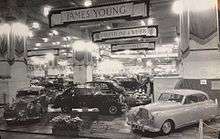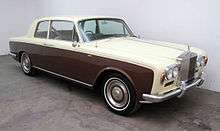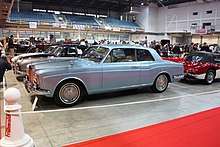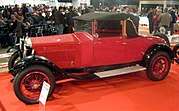James Young (coachbuilder)
James Young Limited was a top class British coachbuilding business in London Road, Bromley, England.
.jpg)
by James Young

Mr James Young bought J. K. Hunter's business in 1863. It built a full range of high quality carriages including landaus but was most famous in James Young's time for its lightweight Bromley Brougham.[1]
Their first car body was made in 1908 on a Wolseley chassis for the local Member of Parliament.[2][3] During the First World War they made ambulances, lorries and armoured cars on Darracq and Hudson chassis.[1] In the 1920s and early 1930s standardised bodies were built for Sunbeam and Talbot along with individual commissions often on Bentley and Rolls-Royce chassis.
James Young Limited joined the Society of Motor Manufacturers and Traders in 1922 and first set up their own stand at the SMMT's 1925 London Motor Show at Olympia.[1] They displayed two bodies: a Chrysler all-weather and a Lanchester saloon.[4]
_(cropped).jpg) Employees invented and patented a new way to make roofs that did not make a drumming noise.[5] They also patented a way to make bodies with parallel opening doors.[2] They made bodies for Bentleys, Rolls-Royce Phantom III's and Wraiths[2] |
In 1937 James Young was bought by London Rolls-Royce dealer Jack Barclay and he persuaded Scotsman A. F. McNeil[6] (1891–1965), 'Mac', to leave J Gurney Nutting & Co to become James Young's chief designer.[1] These two events combined with the end of the depression to produce a sharp rise in James Young's sales.

During the Second World War James Young built aircraft components, mobile canteens and canvas covers. The factory was destroyed and all records lost in 1941, the second year of the Blitz. Rebuilt it was hit again, this time by a V-1 flying bomb but production continued.[1]
Coachbuilding resumed after the war and a stand was taken at the 1948 Motor Show.[3] By the early 1960s 50 or 60 new bodies were being built each year mostly for export. By that time the only Bentley bodies were for Continentals, the last S3 Continental went to its owner in early 1966. Mac McNeil died in 1965.[4]
 James Young version |
 Mulliner Park Ward version |
Some fifty Rolls-Royce Silver Shadow fixed head coupés were created in 1966 and 1967 by removing rear doors from standard unitary construction production cars and extending the front doors. Lacking McNeil's touch they were not a success. Rolls-Royce subsidiary Mulliner Park Ward with more technical information and resources made their coupés at least handsome.[4]
James Young's last bodies were made on Rolls-Royce Phantom V chassis in 1968.[7][8]
Gallery
 Drophead coupé
Drophead coupé
1928 Alfa Romeo
6C 1500 Normale.jpg) 4-seater drophead coupé
4-seater drophead coupé
1930
Sunbeam 16.jpg) Sports car
Sports car
1932
MG F1 Magna_James_Young_Fixed_Head_Coup%C3%A9.jpg) Fixed head coupé
Fixed head coupé
1934
Bentley 3½ Litre.jpg) Drophead coupé
Drophead coupé
1934
Talbot BA105 Coupé
Coupé
1948
Bentley Mark VI Saloon
Saloon
1954
Bentley R-Type Saloon
Saloon
1957
Bentley S Limousine
Limousine
1961
Rolls-Royce Phantom V Owner driver saloon
Owner driver saloon
1965
Bentley Continental S3
Notes
- Martin Bennett. Bentley Continental Corniche & Azure. Veloce 2010. ISBN 1845842103, ISBN 978-1845842109
- Dalton, Lawrence (1975). Coachwork on Rolls-Royce 1906- 1939. p. 361. ISBN 0901564133.
- A-Z of British Coachbuilders. Nick Walker. Bay View Books 1997. ISBN 1-870979-93-1
- Nick Georgano, ed. The Beaulieu Encyclopedia of the Automobile: Coachbuilding. Routledge, 2013. ISBN 1-57958-367-9
- James Young. The Flying Lady, page 722, Rolls-Royce Owners' Club, 1951. accessed 28 December 2018
- Albert Francis McNeil, born 1891 died 1 November 1965, Bromley, Kent. During the war he was with de Havilland aircraft, he returned to James Young
- "Coachbuilding History". coachbuilt.com. Retrieved 3 December 2007.
- Bobbitt, Malcolm (1996), Rolls-Royce Silver Shadow, Bentley T-series, Camargue & Corniche (3rd (2004) ed.), Dorchester, Dorset, UK: Veloce, pp. 135–136, ISBN 1-904788-25-4
External links
Drawings of James Young designs: